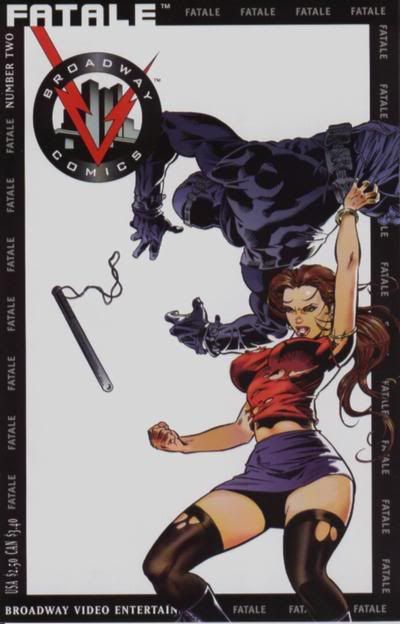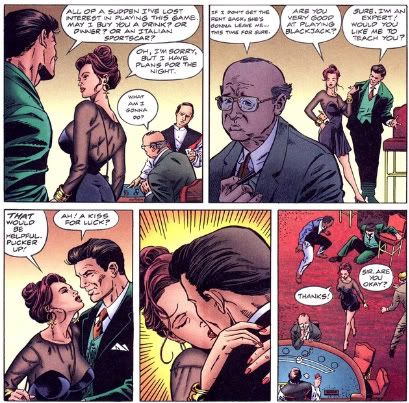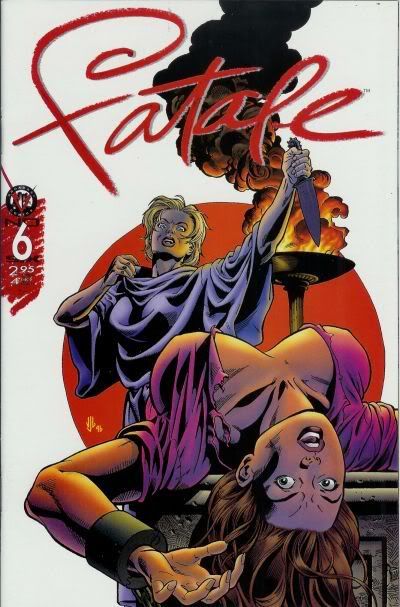A Holy Pilgrimage Continues
*Rancid Self-Promotion Dept: I won't be at San Diego this week; I'll have to get down there one of these years, just to have been there, but not this time.
However, I will be there in spirit through the heavenly grace of Comics Comics #4, a new edition of the world famous PictureBox newspaper-about-comics that most reputable theologians now believe is actually the second coming of Jesus Christ. And while they may not be Christian theologians, well, I think it's still accomplishment enough.
Content details here; the cover feature is Frank Santoro's profile/interview of/with the enigmatic UK comics figure Shaky Kane, and there's added features on Bazooka Joe co-creator Woody Gelman and Kentaro Miura's manga Berserk (new volume out this week, btw). Maggots artist Brian Chippendale reviews recent superhero comics, Kramers Ergot founder Sammy Harkham holds forth on the pamphlet format, and some internet guy writes about Gerald Jablonski and Cryptic Wit (which you can now order online!). Get your copy early, since it's all everyone will be talking about on every panel, including Etiquette: The Dos and Don’ts of Interning for Animation and the Al Jaffee spotlight.
*There's another noteworthy panel going on at 11:00 AM on Thursday (in "Room 8"): The Comic Art of J.G. Jones. I might have stopped in for that one, if I was around, since I'm still moving forward with my quest to read every damn comic that ever featured the Final Crisis artist's interior work. That's not a lot of comics, which maybe provides a clue as to why I picked up this particular quest - you'll never get a series of novels out of my journeys, writers of the fantastic!
Anyway, I just finished the 1996 Broadway Comics series Fatale. I wonder if anyone'll bring that one up?

Broadway Comics is mostly known today as the third time that wasn't the charm in Editor in Chief Jim Shooter's attempts to head an untested comics publisher back in the '90s (it came after Valiant and Defiant). It was intended to be the comics arm of Broadway Video, the Lorne Michaels-founded entertainment company with tendrils in film and television, but it got sold off by its parent to a separate entity that promptly went bankrupt. I'm not sure if many of its series even finished their opening storylines, although Fatale just barely made it; as such, it essentially functions as a standalone miniseries, with the benefit of a consistent art team. I think a trade was planned at some point, but I don't think it ever came out.
This was Jones' second work with Shooter, after Dark Dominion at Defiant. The artist had also been working on a b&w creator-owned vampire series titled Rant (unfinished; Boneyard Press released two issues), which was his first printed work inking his own pencils and stretching into some visual maturity. Fatale is sparser, and conservative in storytelling terms - one might suspect the pressure of producing a monthly-or-so series (bimonthly after issue #3, and in effect quarterly by the concluding issue #6) coupled with Shooter's famed editorial insistence on unadorned narrative clarity to constrain the artist in small boxes. He's inked by Silver Age veteran Frank McLaughlin, who adds a sort of edged quality to the character art.
It all looks a bit stiff, although I'm sure the many included drawings of pretty women helped Jones onward to Shi, then Painkiller Jane/Darkchylde, and eventually Marvel by way of Black Widow. Which led to Marvel Boy, with Grant Morrison, of Final Crisis.

But Fatale is kind of interesting from a writing standpoint too. It's unabashedly a comic-by-committee, with nearly the entire Broadway editorial staff credited with the script on most issues. It's also a very calculated, self-admitted attempt to tap into the then-current 'Bad Girl' boom in American comics, while apparently attempting to correct some of the dumber aspects of the (sub?)genre.
What results is an odd sort of post-feminist (for lack of a better term) superheroine comic about Rogue from the X-Men with the serial numbers filed off and really large breasts. She loves shopping and chocolates, and hates exercise (since she can simply sap strength and knowledge from anyone she touches), but knows how to kick ass. She has a tough uncle who pulls her around by the hair and spanks her, and a strapping super-soldier boyfriend who mainly exists to get tortured and killed so as to affect her; no, it doesn't work any better in the reverse. Sometimes people call her fat, but nearly all men desire her, and she becomes caught between warring factions of a secret society that rules the world. The main villains are her wicked niece who wants to steal the power inside her, and a tough soldier woman whose boyfriend she stole. In the end, she dumps all her romantic partners and becomes top-secret ruler of the world, and kind of depressed.
It's genuinely compelling to see this comic trying to dance between thrills for both genders, and not fall into any pits. At times its blend of bloody shootouts, explosions, comedy, soap opera, 'tough' women, sensuality and very... particularly proportioned bodies makes it seem like a comics-format early draft of the most sprawlingly ambitious, self-regarding Andy Sidaris movie ever. There some moments of rather catchy characterization (after a big fight in which Fatale is captured, the sinister anti-hero/love interest immediately summons oral and plastic surgeons to fix the physical damage done - hello objectification!), and bits wherein saucy maids pull Our Heroine's panties up for her. There's a subtle racial exploitation subtext running through everything. Issue #5 contains the following exchange between an underling and the aforementioned tough soldier woman:
"Layil would like to see you right away."
"In her office?"
"No, ma'am. The steam room."
That issue had six credited writers.

But really the most fun in Fatale occurs outside the story. You see, Shooter ran an obligatory 'strong women who inspired us' editorial in issue #1, praising his grandmothers and mother for their hard work and sacrifices. Perfectly nice; I expect people liked it.
Well, I know one person liked it, since issue #4's letters column features a short missive from Jim Shooter's mom, blessing him for those kind things he said and thanking God for giving her such a wonderful son. It's terribly sweet, but it raises several grave questions. Was Jim Shooter's mom a regular letterhack? Like, does she have anything in the back of The Star Brand ("Al Williamson's inks were phenomenal, pumpkin.")? I know if I'd written Secret Wars II, my mother would totally have supported it, but that's just the kind of woman she is...
However, I will be there in spirit through the heavenly grace of Comics Comics #4, a new edition of the world famous PictureBox newspaper-about-comics that most reputable theologians now believe is actually the second coming of Jesus Christ. And while they may not be Christian theologians, well, I think it's still accomplishment enough.
Content details here; the cover feature is Frank Santoro's profile/interview of/with the enigmatic UK comics figure Shaky Kane, and there's added features on Bazooka Joe co-creator Woody Gelman and Kentaro Miura's manga Berserk (new volume out this week, btw). Maggots artist Brian Chippendale reviews recent superhero comics, Kramers Ergot founder Sammy Harkham holds forth on the pamphlet format, and some internet guy writes about Gerald Jablonski and Cryptic Wit (which you can now order online!). Get your copy early, since it's all everyone will be talking about on every panel, including Etiquette: The Dos and Don’ts of Interning for Animation and the Al Jaffee spotlight.
*There's another noteworthy panel going on at 11:00 AM on Thursday (in "Room 8"): The Comic Art of J.G. Jones. I might have stopped in for that one, if I was around, since I'm still moving forward with my quest to read every damn comic that ever featured the Final Crisis artist's interior work. That's not a lot of comics, which maybe provides a clue as to why I picked up this particular quest - you'll never get a series of novels out of my journeys, writers of the fantastic!
Anyway, I just finished the 1996 Broadway Comics series Fatale. I wonder if anyone'll bring that one up?

Broadway Comics is mostly known today as the third time that wasn't the charm in Editor in Chief Jim Shooter's attempts to head an untested comics publisher back in the '90s (it came after Valiant and Defiant). It was intended to be the comics arm of Broadway Video, the Lorne Michaels-founded entertainment company with tendrils in film and television, but it got sold off by its parent to a separate entity that promptly went bankrupt. I'm not sure if many of its series even finished their opening storylines, although Fatale just barely made it; as such, it essentially functions as a standalone miniseries, with the benefit of a consistent art team. I think a trade was planned at some point, but I don't think it ever came out.
This was Jones' second work with Shooter, after Dark Dominion at Defiant. The artist had also been working on a b&w creator-owned vampire series titled Rant (unfinished; Boneyard Press released two issues), which was his first printed work inking his own pencils and stretching into some visual maturity. Fatale is sparser, and conservative in storytelling terms - one might suspect the pressure of producing a monthly-or-so series (bimonthly after issue #3, and in effect quarterly by the concluding issue #6) coupled with Shooter's famed editorial insistence on unadorned narrative clarity to constrain the artist in small boxes. He's inked by Silver Age veteran Frank McLaughlin, who adds a sort of edged quality to the character art.
It all looks a bit stiff, although I'm sure the many included drawings of pretty women helped Jones onward to Shi, then Painkiller Jane/Darkchylde, and eventually Marvel by way of Black Widow. Which led to Marvel Boy, with Grant Morrison, of Final Crisis.

But Fatale is kind of interesting from a writing standpoint too. It's unabashedly a comic-by-committee, with nearly the entire Broadway editorial staff credited with the script on most issues. It's also a very calculated, self-admitted attempt to tap into the then-current 'Bad Girl' boom in American comics, while apparently attempting to correct some of the dumber aspects of the (sub?)genre.
What results is an odd sort of post-feminist (for lack of a better term) superheroine comic about Rogue from the X-Men with the serial numbers filed off and really large breasts. She loves shopping and chocolates, and hates exercise (since she can simply sap strength and knowledge from anyone she touches), but knows how to kick ass. She has a tough uncle who pulls her around by the hair and spanks her, and a strapping super-soldier boyfriend who mainly exists to get tortured and killed so as to affect her; no, it doesn't work any better in the reverse. Sometimes people call her fat, but nearly all men desire her, and she becomes caught between warring factions of a secret society that rules the world. The main villains are her wicked niece who wants to steal the power inside her, and a tough soldier woman whose boyfriend she stole. In the end, she dumps all her romantic partners and becomes top-secret ruler of the world, and kind of depressed.
It's genuinely compelling to see this comic trying to dance between thrills for both genders, and not fall into any pits. At times its blend of bloody shootouts, explosions, comedy, soap opera, 'tough' women, sensuality and very... particularly proportioned bodies makes it seem like a comics-format early draft of the most sprawlingly ambitious, self-regarding Andy Sidaris movie ever. There some moments of rather catchy characterization (after a big fight in which Fatale is captured, the sinister anti-hero/love interest immediately summons oral and plastic surgeons to fix the physical damage done - hello objectification!), and bits wherein saucy maids pull Our Heroine's panties up for her. There's a subtle racial exploitation subtext running through everything. Issue #5 contains the following exchange between an underling and the aforementioned tough soldier woman:
"Layil would like to see you right away."
"In her office?"
"No, ma'am. The steam room."
That issue had six credited writers.

But really the most fun in Fatale occurs outside the story. You see, Shooter ran an obligatory 'strong women who inspired us' editorial in issue #1, praising his grandmothers and mother for their hard work and sacrifices. Perfectly nice; I expect people liked it.
Well, I know one person liked it, since issue #4's letters column features a short missive from Jim Shooter's mom, blessing him for those kind things he said and thanking God for giving her such a wonderful son. It's terribly sweet, but it raises several grave questions. Was Jim Shooter's mom a regular letterhack? Like, does she have anything in the back of The Star Brand ("Al Williamson's inks were phenomenal, pumpkin.")? I know if I'd written Secret Wars II, my mother would totally have supported it, but that's just the kind of woman she is...

<< Home